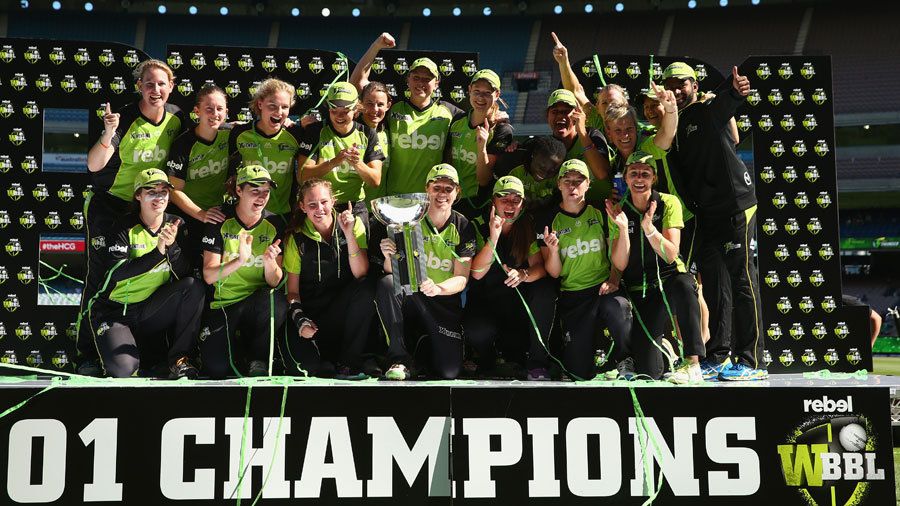And then there were two.
After 22 matches in three countries, England and Australia are the last teams standing. This wouldn’t surprise anyone who looked at the rankings; Australia are the No. 1 team in the world. Neither would it surprise anyone who referred to the results at the most recent ICC tournament; England are the 50-over world champions.
But the two finalists in the Women’s T20 World Cup – as the World T20 was renamed by the ICC on Friday – represent far more than form or even talent; they are a direct reflection of the investment made by their boards in women’s domestic cricket. The Women’s Big Bash League and the Kia Super League are the only high level women’s T20 competitions in the world. Should it surprise anyone that the two squads emerging largely from those competitions have the greatest depth or the experience to adapt and cope with high-pressure situations?
Of course it shouldn’t.
There’s always a chance of an upset in T20, probably more than any other format. A blistering innings, a searing spell, a match-turning moment of brilliance in the field. But this tournament has exposed the glaring gap that threatens to become a yawning chasm if other countries don’t commit to investing in domestic structures and competitions that develop and nurture female talent. It’s all well and good to have high-performance pathways and academies and a handful of central contracts, but it gives Cricket Australia – in particular – a significant advantage in having dozens of battle-hardened and semi-professional or professional players to call on. Players who can come into the squad having fought in regular league and knockout matches, with the added pressure of TV and radio broadcasts and commentators and fans ready to dissect every mistake and poor decision on the field.
Throughout this tournament, England have been without two of their best players, Sarah Taylor and Katherine Brunt. Amy Jones, filling both the wicketkeeping and No. 3 batting position vacated by Taylor, stepped up admirably. In the semi-final against India, she showed both grit and the ability to learn from the innings played earlier and adapt to the difficult batting conditions. She was watchful and played most of her shots off the back foot, whereas India had paid the price for coming down the pitch and attacking.
In Brunt’s absence, England’s left-arm spinners came to the fore; Sophie Ecclestone and the particularly impressive Kirstie Gordon taking wickets and bouncing back from any mistakes with a composure that, like Jones, was honed in the KSL.
For Australia, a side bursting with experience and class, there have been few opportunities for the younger lot to strut their stuff but Sophie Molineux and Georgia Wareham have not been overwhelmed when opportunities have arisen.
Consider the players from other teams who won’t appear in Saturday’s final: Harmanpreet Kaur, Smriti Mandhana, Deandra Dottin, Hayley Matthews, Marizanne Kapp, Lizelle Lee, Chamari Attapattu, Amy Satterthwaite and Suzie Bates, just to name a few. All of them have played in both the WBBL and the KSL. Good performances for their countries may have earned them a contract but they have all gained immeasurably from the experience.
Even Kim Garth and Isobel Joyce have belied the amateur status of cricket in Ireland to land contracts in the WBBL, and the positive effect on Garth, in particular, has been significant.
Still, there are financial constraints to overcome of course, but it is worth considering the long-term path taken by Australia. When CA first announced new contracts in 2013 they chose to cap the national contracts at an amount that allowed them to pay a small but significant retainer to state players. Since then, with each increase to the national contracts have come a similar rise in payments to domestic players, culminating in the recent memorandum of understanding that sees around 120 players able to make some kind of living from playing cricket. If the original idea was a little “Marxist”, it has evolved into a product that makes “capitalist” sense, and the women’s domestic competitions are a serious marketing asset that also gives the game depth and reach.
The ECB has been playing catch-up, trying to match national contracts but still relying heavily on the academy pathway thanks to an unwieldy amateur county system. And yet, in just two years, the KSL has unearthed and developed the kind of talent to succeed on the world stage while providing an attractive broadcast product and drawing decent crowds and new fans. But even in England the future of domestic cricket is hazy at best: beyond the new hundred-ball competition nothing has yet been decided beyond next season. Success in the T20 World Cup final may help focus thoughts.
Not every country will be able to sustain its own WBBL or KSL but there is scope for other boards to invest more, even if only a little. If the BCCI is disappointed with India’s exit from the T20 World Cup, what is there to stop it from instigating a Women’s IPL or improving its other domestic structures? Can other boards adopt the long-term “Marxist” approach taken by Australia and develop competitions that are small enough to maintain high standards and provide at least a nominal retainer?
Other cash-strapped boards, such as West Indies or Ireland, would find this difficult and there are also disheartening instances of neglect, such as Pakistan’s players being deprived of their monthly retainers for more than six months.
Too many countries have a small gold capstone sitting atop a hollow pyramid. This is their domestic structure. The recent FICA report into the state of the women’s international game was Nostradamus-like if you considered it a predictor or how this tournament would unfold.
So as the setting Antiguan sun illuminates the battle for the final prize, as the players representing England and Australia repay the investment made in their professionalism, let us ponder the question.
How much better could it be?
